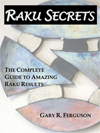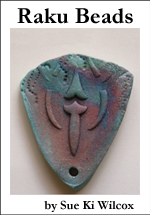|
June 2006 Issue #39
Published by
Gary R. Ferguson – Raku Artist
~-~-~-~-~-~-~-~-~-~-~-~-~-~--~-~-~-~-~-~-~-~-~-~-~
In This Issue
* While the Smoke Clears
* I’ve seen the light...
* 411 on ITC
* Another Crawling Cause
* N&ked Firing Revisited – Wally Asselberghs
* Raku Links
* Workshops
* Pottery Business Available
~-~-~-~-~-~-~-~-~-~-~-~-~-~-~-~-~-~-~-~-~-~-~-~-~-~-~-~-~-~
*
N&ked Refiring Revisited
by
Wally Asselberghs
Some
additional feedback on the "refiring N&ked Raku" topic
discussed last issue:
I agree with you about not recommending to apply a clear Raku glaze on top
of a n&ked Raku surface, and then fire it again. Most likely, the
original surface will be burnished to some extent or another, and the Raku
glaze will not melt down the way it should normally do on a rougher
bisqued surface. Chances are very high that the glaze will peel off later
on, completely or partially. Most of the time this is not very aesthetical
pleasing.
On the other hand, my personal experience in regard of "carbon
burning off if the piece is refired" is a little bit different.
First of all, I always tell students during my workshops that one of the
great advantages of n&ked Raku is that you can always start all over
again, if the results are not satisfactory after the first firing.
Just remove all remnants of glaze layer and slip layer, and fire again in
a bisque kiln. Not even necessary to fire up to full bisque
temperature. When looking through the peephole, most carbon has
disappeared around 500° Celcius, and everything is gone once you have
passed the 600° Celcius barrier.
I have re-fired a lot of my personal work, even 2 to 3 times, including
objects that were made of slabs and scorched together.
One student in Arizona once asked me what would happen if the object was
not bisqued again, but a new layer of slip and glaze was just put on top
of the original result, and fired again in a second kiln firing. I decided
to consider it an experiment, and tried it out at the second day of the
workshop.
It turned out really nice.
Though most of the original carbon marks had faded away, you could
still see some of the original smoke patterns left behind by the first
firing, though quite subdued.
Looked like some kind of patchwork, and certainly opened up some new
perspectives.
Though I never tried it again, I kept the idea in the back of my mind for
further experiments.
~-~-~-~-~-~-~-~-~-~-~-~-~-~-~-~-~-~-~-~-~-~-~-~-~-~-~-~-~-~
Raku:
A Practical Approach by Steven Branfman
The
“nuts and bolts” how-to book of Raku
Order
30% off at: http://www.garyrferguson.com/branfman
~-~-~-~-~-~-~-~-~-~-~-~-~-~-~-~-~-~-~-~-~-~-~-~-~-~-~-~-~-~
.
|



